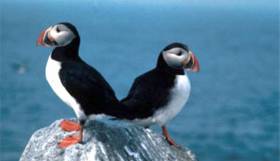Displaying items by tag: Puffin
A wildlife charity has urged the public to take care when disposing of face masks after it’s alleged a puffin became entangled in a mask and died.
According to The Irish Times, the Irish Wildlife Trust (IWT) said it was sent the distressing image it shared on its Instagram, showing the seabird with a disposable face mask wrapped around its face and underneath a wing.
Birdwatch Ireland says it has also received reports of birds caught in recklessly discarded masks, though it is not clear how widespread the problem may be.
But the IWT says that even a small number of cases adds to “the issue of marine litter and plastic waste that we know presents serious issues for wildlife”.
The Irish Times has more on the story HERE.
Rathlin West Light Seabird Centre Will Reopen in May
The Rathlin RSPB (Royal Society for Protection of Birds) has announced the Rathlin West Light Seabird Centre will re-open on Saturday 29th May in line with the NI Executive's indicative date for visitor attractions. This, of course, may be subject to review.
Rathlin lies about six miles off the North Antrim coast opposite Ballycastle and is reached by the Ballycastle -Rathlin ferry.
The Seabird Centre is four miles west of the Harbour on the site of the unique 'Upside Down' lighthouse. It can be reached by private bus, bicycle or on foot.
There are unrivalled close-up views of Northern Ireland's largest seabird colony and a chance to explore the lighthouse, part of the Great Lighthouses of Ireland Trail. There is a 158-step descent to the viewing platform and lighthouse.
The centre is open daily until 19th September from 10 am – 5 pm (last entry 4 pm).
Impressed By Puffins As Birdwatch Ireland Conduct Seabird Survey
Without a lot of public attention Birdwatch Ireland, the conservation organisation which protects Ireland's birds and their habitats, is engaged in an extensive survey of seabirds. Ireland is a very important country for seabirds which are, in my view, marvellous creatures of Nature. The variety of seabirds around our coastline is huge, but they are facing several threats and, if the issues are not resolved, some species could face extinction.
Sailing around the coastline I have marvelled at seabirds. One of my best memories is of a Summer’s evening heading towards Valentia Island on the Kerry coast.
Passing Puffin Island is an experience to remember. It is an Irish wildbird conservancy reserve of Birdwatch Ireland, near Portmagee. It is separated from the mainland by a narrow sound and is, at times, home to thousands of pairs of Manx Shearwaters, Storm Petrels and Puffins and smaller numbers of other breeding seabirds.
I was particularly impressed by the Puffins with their coloured bills and black-and-white coats, almost looking particularly well-dressed for a formal evening out.
I thought the Puffins were the most magnificent of birds and admired them while sailing past.
For this edition of my radio programme I spent a very pleasant hour or so with Niall Hatch, Development Officer of Birdwatch Ireland discussing why Ireland is such an important location for seabirds and why it is vital to support work being undertaken to ensure their future and, particularly, that of species which are threatened with extinction.
“Ireland is incredibly important for seabirds. We are home to populations of many scarce and threatened species,” Niall told me. “Given our location, at the very edge of Europe, we are the last point of departure as they leave and the first port-of-call for those coming in from the Atlantic.
On this week’s THIS ISLAND NATION, which you can listen to below, he outlines the threats of extinction faced by several species of seabirds, describes the survey work being done in this regard and, in a wider perspective, talks about the involvement of Birdwatch Ireland internationally and the efforts to protect that legendary bird associated with the sea, the Albatross.
























































